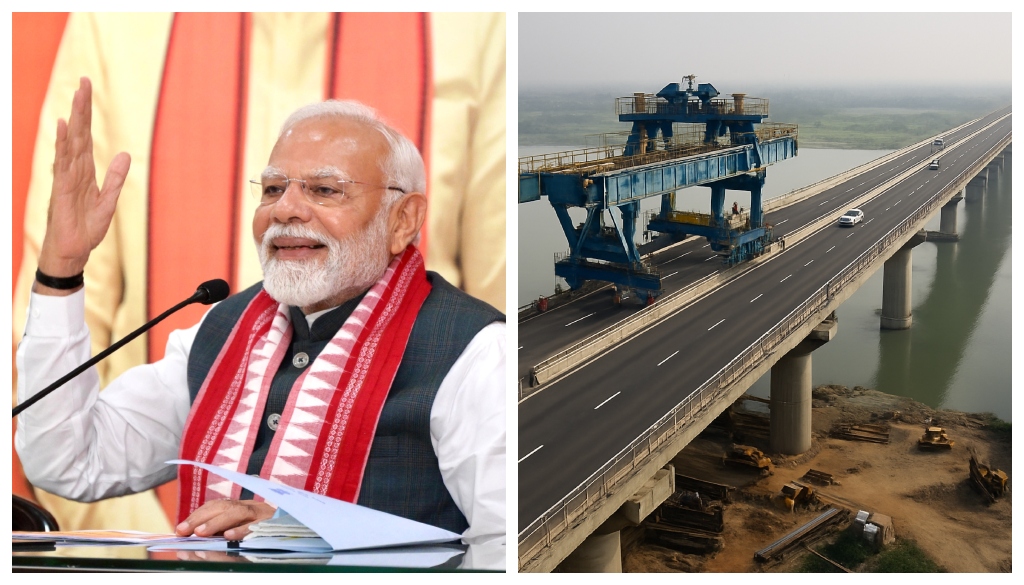
Patna: Ten years after Prime Minister Narendra Modi announced a special package of Rs 1.25 lakh crore for Bihar during the 2015 election campaign, the state is witnessing a visible transformation in its transport infrastructure — from new highways to expanded rail networks and upgraded airports.
While some additional allocations were made in subsequent years, government officials say that most of the projects originally announced under this package are nearing completion, helping deliver on the promise of a ‘double engine’ government driving Bihar’s growth.
The centrepiece of the package lies in the Ministry of Road Transport and Highways, which committed to 74 projects covering 2,836 kilometres of roads at a cost of Rs 51,540 crore. Of these, 44 projects have already been completed, adding 1,304 km of new roads at a total expenditure of Rs 14,898 crore.
Among the flagship projects are the reconstruction of Mahatma Gandhi Setu — a vital lifeline across the Ganges — at a cost of Rs 1,742 crore, the Patna-Gaya-Dobhi highway (Rs 1,680 crore), Simaria-Khagaria four-lane highway (Rs 1,063 crore), and the Bhojpur-Buxar section of NH-84 (Rs 595 crore). The Kailwar-Bhojpur four-lane road has also been completed at Rs 750 crore.
Pushing Ahead With 22 Ongoing Road Projects
Work is currently under way on 22 more road projects, covering 1,057 km and costing Rs 25,933 crore. According to officials, 11 of these will be completed by the end of the current financial year, with the remainder targeted for completion by 2027-28.
Additionally, five new projects spanning 271 km and costing Rs 5,797 crore are expected to begin soon. Two more are awaiting final approvals.
One project, the Sonbarsa-Raxaul road, has been postponed as the stretch falls under the Ministry of Defence’s India-Nepal border roads initiative.
Among the major ongoing works are the four-lane bridge parallel to Mahatma Gandhi Setu, the Patna-Koilwar highway, the Umgaon-Saharsa road and its associated Kosi bridge, the Munger-Mirzachowki four-lane road, and the new Vikramshila Setu across the Ganges.
Railways: Laying New Tracks For Growth
Rail connectivity is also seeing a major boost. Out of nine railway projects under the Bihar package, five have been completed, with four more nearing completion.
A total of 652 km of new or double-track rail lines have been laid so far at a cost of Rs 4,841 crore. Work is ongoing on another 466 km of lines, with an investment of Rs 7,736 crore.
Among the key projects scheduled for completion this year are the doubling of the Kiul-Gaya line, the Samastipur-Darbhanga section, the third line between Dhanbad and Sonnagar, and the Rampur Dumra Tal section, as well as construction work on Rajendra Bridge.
Airports: Expanding Bihar’s Wings
Air connectivity is another priority area, with airports planned for five cities apart from the capital Patna.
At Patna’s Jayaprakash Narayan International Airport, a Rs 1,216 crore upgrade has delivered a new terminal and associated infrastructure. Gaya airport has also been modernised at a cost of Rs 68.72 crore.
Construction of new airports is set to begin soon in Bihta and Purnia. The foundation stone for Bihta Airport was recently laid by Prime Minister Modi alongside the inauguration of Patna Airport’s new terminal.
Meanwhile, land surveys are ongoing in Raxaul to pave the way for a new airport there.
The Road Ahead
With significant progress in its road, rail and air networks, Bihar’s long-promised infrastructure overhaul appears to be gathering pace.
Officials say that these projects are already improving connectivity across the state — particularly between north and south Bihar — and are expected to spur further economic development in the coming years.
For a state long hampered by inadequate infrastructure, the impact of this decade-long transformation could well be profound.





